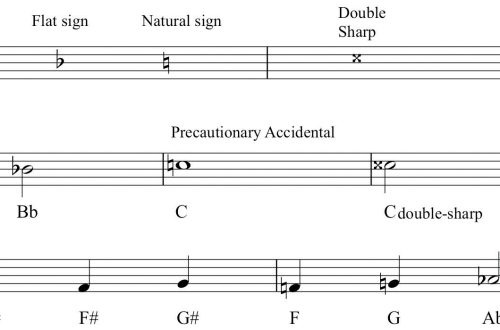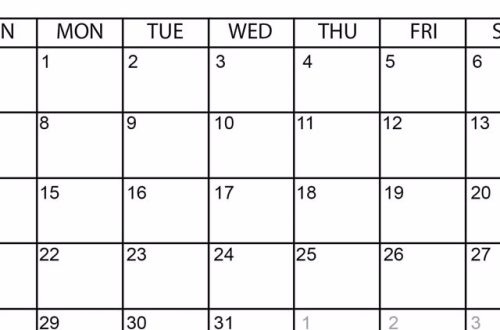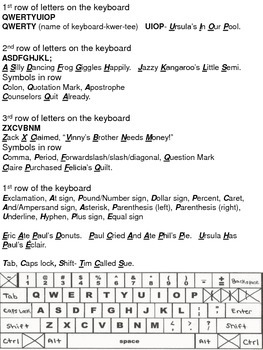
How to remember signs in keys?
Contents
In the next issue, we will teach you how to memorize signs in keys, introduce you to techniques that will allow you to instantly identify signs in any key.
Let’s say right away that you can simply take and learn the signs in all keys as a multiplication table. It’s not as difficult as it seems. For example, the author of these lines did just that: being a student of the second grade of a music school, having spent 20-30 minutes, he honestly memorized what was dictated by the teacher, and after that there were no more problems with memorization. By the way, for those who like this method, and for everyone who needs a key cheat sheet for solfeggio lessons, at the end of this article a table of keys and their signs with a key with the possibility of downloading will be provided.
But if it’s just that you’re not interested in learning, or if you just can’t bring yourself to sit down and learn, then just keep reading what we have prepared for you. We will master all the keys in a logical way. And also, train – for this, in the course of the article there will be special tasks.
How many keys are there in music?
In total, 30 main keys are used in music, which can be divided into three groups:
- 2 keys without signs (remember immediately – C major and A minor);
- 14 keys with sharps (of which 7 are major and 7 are minor, in each major or minor key there are from one to seven sharps);
- 14 keys with flats (including 7 major and 7 minor, each with from one to seven flats).
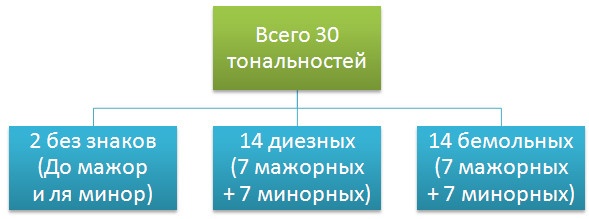
Keys in which the same number of characters, that is, the same number of flats or sharps, are called parallel keys. Parallel keys “exist in pairs”: one of them is major, the other is minor. For example: C major and A minor are parallel keys, since they have the same number of characters – zero (they are not there: there are no sharps or flats). Or another example: G major and E minor are also parallel keys with one sharp (F sharp in both cases).

Tonics of parallel keys are at a distance of an interval of a minor third from each other, therefore, if we know any one key, then we can easily find a parallel one and find out how many signs it will have. You can read about parallel keys in detail in the previous issue of our site. You need to be able to find them quickly, so let’s recall some rules.
Rule No. 1. To find a parallel minor, we build a minor third down from the first degree of the original major key. For example: the key is F-major, the minor third from F is F-D, therefore, D-minor will be a parallel key for F major.

Rule No. 2. To find a parallel major, we build a small third, on the contrary, upwards from the first step of the minor key known to us. For example, the tonality of G minor is given, we build a small third upwards from G, we get the sound of B-flat, which means that B-flat major will be the desired parallel major key.

How to distinguish between sharp and flat keys by name?
Let’s make a reservation right away that there is no need to memorize everything right at once. First, it’s better to figure it out, only with major keys, because there will be the same signs in minor parallels.
So, how to distinguish between sharp and flat major keys? Very simple!
The names of flat keys usually contain the word “flat”: B-flat major, E-flat major, A-flat major, D-flat major, etc. An exception is the key of F major, which is also flat, although the word flat is not mentioned in its name. That is, in other words, in such keys as G-flat major, C-flat major or F major, there will definitely be key flats (from one to seven).
The names of sharp keys either do not mention any accidentals, or the word sharp is present. For example, the keys of G major, D major, A major, F sharp major, C sharp major, etc. will be sharp. But here, relatively speaking, there are also simple exceptions. C major, as you know, is a key without signs, and therefore it does not apply to sharp. And one more exception – again, F major (it is a flat key, as we have already said).
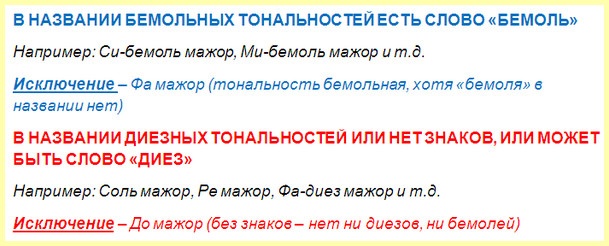
And let’s repeat again RULES. If there is the word “flat” in the title, then the key is flat (the exception is F major – also flat). If there is no word “flat” or there is a word “sharp”, then the key is sharp (exceptions are C major without signs and flat F major).
Sharp order and flat order
Before we proceed to the actual definition of the actual signs in a particular key, we first deal with such concepts as the order of sharps and the order of flats. The fact is that sharps and flats in keys appear gradually and not randomly, but in a strictly defined sequence.
The order of sharps is as follows: FA DO SOL RE LA MI SI. And, if there is only one sharp in the scale, then it will be exactly F-sharp, and not some other one. If there are three sharps in the key, then, respectively, these will be F, C and G-sharp. If there are five sharps, then F-sharp, C-sharp, G-sharp, D-sharp and A-sharp.
The order of the flats is the same order of the sharps, only “topsy-turvy”, that is, in the sideways movement: SI MI LA RE SOL DO FA. If there is one flat in the key, then it will be exactly B-flat, if there are two flats – si and mi-flat, if there are four, then si, mi, la and re.
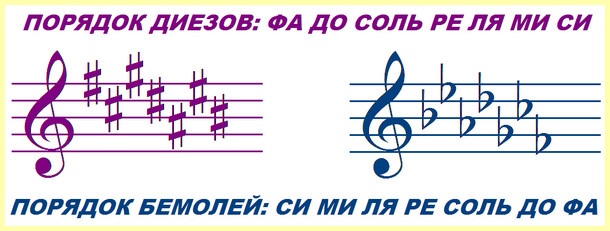
The order of sharps and flats must be learned. It’s easy, fast, and very useful. You can learn by simply saying each row aloud 10 times, or remember them as the names of some fairy-tale characters, such as Queen Fadosol re Lamisi and King Simil re Soldof.
Determining signs in sharp major keys
In sharp major keys, the last sharp is the penultimate step before the tonic, in other words, the last sharp is one step lower than the tonic. The tonic, as you know, is the first step of the scale, it is always present in the name of the key.

For example, the let’s take the key of G major: the tonic is the note G, the last sharp will be a note lower than the G, that is, it will be F sharp. Now we go in order of sharps FA TO SOL RE LI MI SI and stop at the desired last sharp, that is, fa. What happens? You need to stop right away, on the very first sharp, as a result – in G major there is only one sharp (F-sharp).
Another example. Let’s take the key of E major. What tonic? Mi! What sharp will be the last one? Re is one note lower than mi! We go in order of sharps and stop at the sound “re”: fa, do, sol, re. It turns out that there are only four sharps in E major, we just listed them.
INSTRUCTIONS to find sharps: 1) determine the tonic; 2) determine which sharp will be the last; 3) go in order of sharps and stop at the desired last sharp; 4) formulate a conclusion – how many sharps are in the key and what they are.
TRAINING TASK: determine the signs in the keys of A major, B major, F-sharp major.
SOLUTION (answer questions for each key): 1) What is the tonic? 2) What will be the last sharp? 3) How many sharps will there be and which ones?
ANSWERS:
- A major – tonic “la”, the last sharp – “salt”, total sharps – 3 (fa, do, salt);
- B major – tonic “si”, the last sharp – “la”, total sharps – 5 (fa, do, sol, re, la);
- F-sharp major – tonic “F-sharp”, the last sharp – “mi”, total sharps – 6 (fa, do, sol, re, la, mi).
[collapse]
Determining signs in flat major keys
In flat keys, it’s a little different. First of all, you need to remember that in the key-exception, F major is only one flat (the first in order is B-flat). Further, the rule is as follows: the tonic in a flat key is the penultimate flat. To determine the signs, you need to go in the order of flats, find the name of the key in it (that is, the name of the tonic) and add one more, the next flat.
![]()
For example, the Let’s define the signs of A-flat major. We go in order of flats and find A-flat: si, mi, la – here it is. Next – add another flat: si, mi, la and re! We get: in A-flat major there are only four flats (si, mi, la, re).
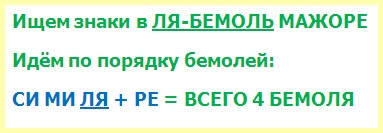
Another example. Let’s define signs in G-flat major. We go in order: si, mi, la, re, salt – here is the tonic and we also add one next flat – si, mi, la, re, SALT, do. In total, there are six flats in G-flat major.

INSTRUCTIONS to find flats: 1) go in the order of flats; 2) reach the tonic and add one more flat; 3) formulate conclusions – how many flats are in the key and which ones.
TRAINING TASK: determine the number of characters in the keys of B-flat major, E-flat major, F-major, D-flat major.
SOLUTION (we act according to the instructions)
ANSWERS:
- B-flat major – only 2 flats (SI and mi);
- E-flat major – only 3 flats (si, MI and la);
- F major – one flat (si), this is an exception key;
- D-flat major – only 5 flats (si, mi, la, PE, salt).
[collapse]
How to identify signs in minor keys?
For minor keys, of course, one could also come up with some convenient rules. For example: in sharp minor keys, the last sharp is a step higher than the tonic, or in flat minor keys, the last flat is two steps lower than the tonic. But an excessively large number of rules can cause confusion, so it is best to determine signs in minor keys by parallel major ones.
INSTRUCTIONS: 1) first determine the parallel major key (to do this, we rise to the interval of a minor third from the tonic); 2) determine the signs of the parallel major key; 3) the same signs will be in the original minor scale.
For example. Let’s define the signs of F-sharp minor. It is immediately clear that we are dealing with sharp keys (the word “sharp” in the title has already shown itself). Let’s find a parallel tone. To do this, we set aside a small third upwards from the F-sharp, we get the sound “la” – the tonic of the parallel major. So, we now need to find out what signs are in A major. In A major (sharp key): the tonic is “la”, the last sharp is “sol”, there are three sharps in total (fa, do, sol). Therefore, in F-sharp minor there will also be three sharps (F, C, G).

Another example. Let’s define the signs in F minor. It is not yet clear whether this is a sharp key or a flat one. We find parallelism: we build a small third upwards from “fa”, we get “a-flat”. A-flat major is a parallel system, the name contains the word “flat”, which means that F minor will also be a flat key. We determine the number of flats in A-flat major: we go in the order of flats, we reach the tonic and add one more sign: si, mi, la, re. In total – four flats in A flat major and the same number in F minor (si, mi, la, re).
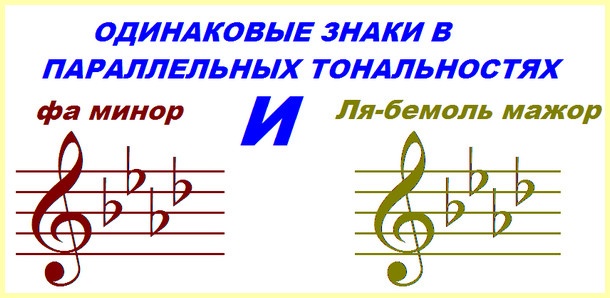
TASK FOR TRAINING: Find signs in the keys C-sharp minor, B minor, G minor, C minor, D minor, A minor.
SOLUTION (we answer the questions and gradually come to the necessary conclusions): 1) What is the parallel tone? 2) Is it sharp or flat? 3) How many signs are in it and which ones? 4) We conclude – what signs will be in the original key.
ANSWERS:
- C-sharp minor: parallel tonality – E major, it is sharp, sharps – 4 (fa, do, salt, re), therefore, there are also four sharps in C-sharp minor;
- B minor: parallel key – D major, it is sharp, sharps – 2 (F and C), in B minor, thus, there are also two sharps;
- G minor: parallel major – B-flat major, flat key, flat – 2 (si and mi), which means that there are 2 flats in G minor;
- C minor: parallel key – E-flat major, flat, flat – 3 (si, mi, la), in C minor – similarly, three flats;
- D minor: parallel key – F major, flat (key-exception), only one B-flat, in D minor there will also be only one flat;
- A minor: parallel key – C major, these are keys without signs, there are no sharps or flats.
[collapse]
Table “Tones and their signs at the key”
And now, as promised at the beginning, we offer you a table of keys with their key signs. In the table, parallel keys with the same number of sharps or flats are written together; the second column gives the letter designation of keys; in the third – the number of characters is indicated, and in the fourth – it is deciphered which particular characters are in a particular scale.
KEYS | LETTER DESIGNATION | NUMBER OF CHARACTERS | WHAT SIGNS |
KEYS WITHOUT SIGNS | |||
| C major // A minor | C-dur // a-moll | no signs | |
SHARP KEYS | |||
| G major // mi minor | G-dur // e-moll | 1 sharp | F |
| D major // B minor | D major // B minor | 2 sharps | Fah, do |
| A major // F sharp minor | A-dur // fis-moll | 3 sharps | Fa, to, salt |
| E major // C-sharp minor | E major // C sharp minor | 4 sharps | Fa, do, salt, re |
| B major // G-sharp minor | H-dur // gis-moll | 5 sharps | Fa, do, sol, re, la |
| F-sharp major // D-sharp minor | Fis-dur // dis-moll | 6 sharps | Fa, do, sol, re, la, mi |
| C-sharp major // A-sharp minor | C sharp major // Ais minor | 7 sharps | Fa, do, sol, re, la, mi, si |
FLAT TONS | |||
| F major // D minor | F-dur // d-moll | 1 flat | Si |
| B flat major // G minor | B-dur // g-moll | 2 flats | Si, mi |
| E flat major // C minor | Es-dur // c-moll | 3 flats | Si, mi, la |
| A flat major // F minor | As-dur // f-moll | 4 flats | Si, mi, la, re |
| D flat major // B flat minor | Des-hard // b-moll | 5 flat | Si, mi, la, re, sol |
| G-flat major // E-flat minor | Ges-dur // es-moll | 6 flat | Si, mi, la, re, sol, do |
| C-flat major // A-flat minor | These-hard // as-soft | 7 flat | Si, mi, la, re, sol, do, fa |
This table can also be downloaded for printing if you need a solfeggio cheat sheet – DOWNLOAD. After a little practice of working with different keys, most of the keys and signs in them are remembered by themselves.
We suggest you watch the video on the topic of the lesson. The video offers another similar way of memorizing key characters in various keys.



